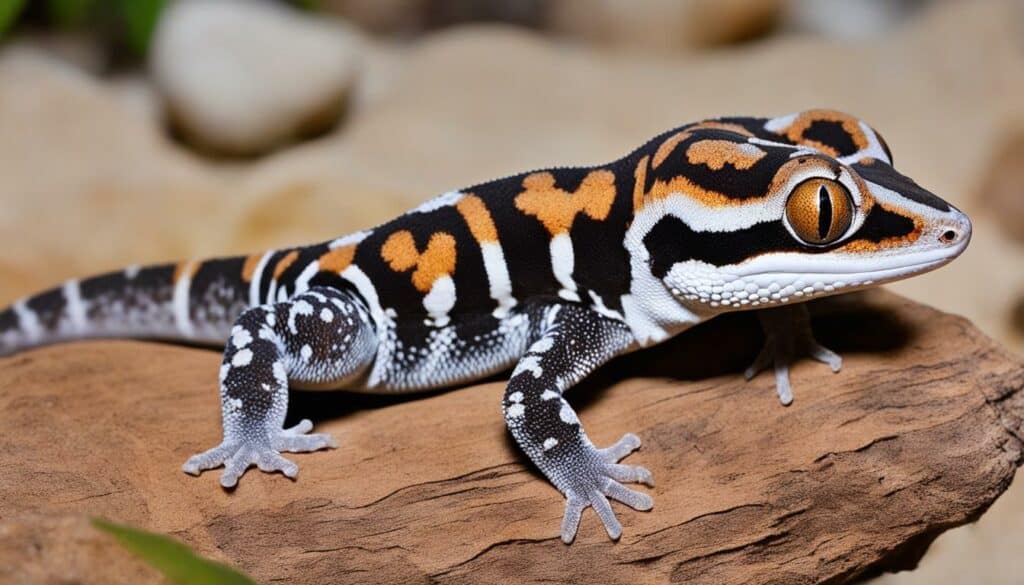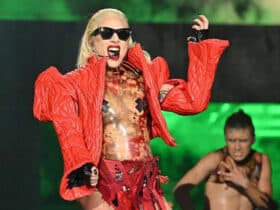Are you considering adding a fat tail gecko to your family? These fascinating reptiles make excellent pets, but they do require specific care to thrive in captivity. In this guide, we will provide you with all the information you need to care for your fat tail gecko, from creating the perfect enclosure to providing a balanced diet and monitoring their health.
Fat tail geckos are unique animals with specific requirements for their habitat and diet. With proper care and attention, you can ensure that your gecko is healthy, happy, and thriving in their home. Let’s get started with the basics of fat tail gecko care.
Key Takeaways:
- Caring for fat tail geckos requires specific knowledge and attention to detail
- A suitable enclosure is crucial to their health and well-being
- Proper nutrition and hydration are essential elements of their care
- Handling and taming techniques can help build a bond with your gecko
- Routine monitoring and veterinary care can help maintain their health over the long-term
Introduction to Fat Tail Gecko Care
Are you considering getting a pet fat tail gecko? Proper fat tail gecko care is crucial for their health and well-being. Fat tail geckos are easy-going, docile creatures that make great pets. They’re also known for their distinct fat tails and unique patterns.
Caring for fat tail geckos involves providing them with a proper habitat, regular feeding, and proper handling. It’s important to understand their unique needs regarding temperature, humidity, and substrate. With the right fat tail gecko husbandry, you can ensure your pet is comfortable and happy.
Key Takeaways
- Proper fat tail gecko care is crucial for their health and well-being
- Caring for fat tail geckos involves providing them with a proper habitat, regular feeding, and proper handling
- Understanding their unique needs regarding temperature, humidity, and substrate is essential
- Fat tail geckos are easy-going, docile creatures that make great pets
- With the right care, you can ensure your pet is comfortable and happy
Creating the Perfect Fat Tail Gecko Enclosure
Setting up an ideal enclosure is crucial for the overall health and well-being of your fat tail gecko. Here are some guidelines to follow for a perfect fat tail gecko setup:
Housing Equipment
The type and size of the enclosure are essential elements to consider, as well as the materials for constructing it. An adult fat tail gecko needs a minimum enclosure size of 20 gallons, with an additional 10 gallons per additional gecko. The enclosure needs secure lids, proper ventilation, and a sturdy base. A hide box, water dish, and branches are essential housing equipment items that should be available in the enclosure.
Substrate Choices
The substrate you choose will help maintain the enclosure’s humidity and provide a comfortable basking spot. There are various substrate options, including coconut coir, cypress mulch, and reptile carpet. Avoid using sand or loose and small materials that your gecko may accidentally ingest.
Temperature and Humidity
Proper temperature and humidity levels are vital for fat tail gecko health, as they require a warm and humid environment to thrive. The optimal temperature for a fat tail gecko’s enclosure is between 88-92°F (31-33°C) during the day and around 75-78°F (24-26°C) during the night. The humidity levels should be maintained between 60-70%.
To maintain optimal temperature and humidity, well-regulated lighting and heating equipment are necessary. You can use a heat lamp, under-tank heating pad, or ceramic heat emitter. A thermometer and hygrometer are necessary tools to monitor the enclosure’s temperature and humidity levels.
“Proper temperature, humidity, and substrate choices are crucial factors for creating a comfortable and healthy environment for your fat tail gecko.”
Providing a Balanced Diet for Your Fat Tail Gecko
Feeding your fat tail gecko with a balanced diet is crucial to keep them healthy and happy. In this section, we will talk about the nutritional needs of fat tail geckos and how to meet those needs through proper feeding.
Fat Tail Gecko Diet Basics
Fat tail geckos are carnivores, which means they feed on insects and small prey. The main diet of a fat tail gecko should comprise of crickets, superworms, mealworms, wax worms, and roaches. You can also feed your gecko with occasional treats like pinky mice.
Suitable Feeder Insects for Fat Tail Geckos
Not all insects are suitable for fat tail geckos. You need to make sure to provide the right size of insect as per your gecko’s size. Tiny crickets or mealworms are ideal for baby geckos, while adults can handle larger insects. Feeding your gecko with a variety of insects can enhance their nutritional intake.
| Insects | Nutrient Content |
|---|---|
| Crickets | High in protein and low in fat |
| Superworms | High in fat and protein |
| Mealworms | Low in calcium and hard to digest |
| Wax worms | High in fat and not suitable for regular feeding |
| Roaches | High in protein and low in fat |
Supplementation
While feeding your gecko with insects provides them the required nutrients, it is important to supplement their diet with vital vitamins and minerals. You can dust the insects with calcium and vitamin D3 supplements to prevent calcium deficiency and metabolic bone disease. Additionally, you can add multivitamin supplements to their diet every other feeding.
Feeding Schedule
Feeding your gecko every day is not necessary. Adult geckos can be fed two to three times a week, while juveniles require more frequent feeding. Always remove any uneaten insects to prevent them from dying in the enclosure and causing health issues. If you are unsure about how much or how often to feed your gecko, consult a veterinarian.
In conclusion, a balanced and nutritious diet is essential for the well-being of your fat tail gecko. Follow these tips on feeding and supplementing to keep your gecko healthy and happy.
Proper Handling and Taming Techniques
Handling and taming your fat tail gecko can be enjoyable and rewarding. Here are some tips to help you build trust, create a bond, and safely handle your pet:
- Start by allowing your gecko to get used to your presence before attempting to handle it.
- Approach your gecko slowly and avoid making sudden movements or loud noises that may startle it.
- Gently scoop your gecko up from below and support its body with your hands, being careful not to squeeze or apply too much pressure.
- Avoid grabbing your gecko’s tail as it can easily break off as a defense mechanism.
- Handle your gecko for short periods initially and gradually increase the time as it becomes more comfortable with you.
- Offer food to your gecko by hand, allowing it to associate you with positive experiences and rewards.
Remember that each gecko has a unique personality, and it may take some time for your pet to become comfortable with handling.
Expert Tip: Don’t attempt to handle your fat tail gecko during shedding periods as its skin will be sensitive and fragile, leading to potential injury or harm.
Building a bond with your fat tail gecko takes patience and time, but the rewards are worth it. With proper handling techniques, your pet can become a friendly and interactive companion.
Common Mistakes to Avoid
Here are some common mistakes to avoid when handling your fat tail gecko:
| Mistakes | Best Practices |
|---|---|
| Grabbing the gecko’s tail | Avoid grabbing the tail as it can break off easily and cause injury to your pet. |
| Handling too frequently or forcefully | Give your gecko time to acclimate to its new environment and handle it with care to avoid stress or harm. |
| Not washing hands prior to handling | Wash your hands thoroughly before handling your gecko to avoid transferring bacteria or toxins that may harm your pet. |
| Allowing children to handle unsupervised | Always supervise children when handling your gecko to ensure their safety and the safety of your pet. |
By avoiding common mistakes and following proper handling techniques, you can create a strong bond with your fat tail gecko and enjoy its company for years to come.
Maintaining Optimal Temperature and Humidity Levels
When it comes to creating a healthy environment for your fat tail gecko, maintaining the right temperature and humidity levels is crucial. Failure to do so can result in a range of health issues that can be harmful to your pet.
Temperature Requirements
The ideal temperature for a fat tail gecko habitat is between 88-92°F during the day and 70-75°F at night. This can be achieved by providing a heat source, such as an under-tank heater or heat lamp, on one side of the enclosure.
“Creating a suitable habitat with a consistent temperature range will help your fat tail gecko live a happy and healthy life.”
Humidity Requirements
The ideal humidity level for a fat tail gecko enclosure is between 40-60%. This can be achieved by adding a shallow bowl of water to the enclosure and misting the enclosure daily. It’s important to monitor the humidity levels regularly to ensure they are within the suitable range.
Choosing Suitable Heating and Lighting Options
When choosing heating and lighting options for your fat tail gecko enclosure, it’s crucial to select options that provide the appropriate temperature and lighting requirements. A UVB bulb can be used to provide the necessary lighting that helps to promote the overall well-being of your pet.
Summary Table of Temperature and Humidity Requirements
| Criteria | Daytime Temperature | Nighttime Temperature | Humidity |
|---|---|---|---|
| Ideal Range | 88-92°F | 70-75°F | 40-60% |
By providing an appropriate temperature and humidity range, suitable lighting options, and regularly monitoring and maintaining the conditions in your fat tail gecko’s habitat, they can live happily and healthily in their enclosure.
Monitoring and Preventing Common Health Issues
Keeping your fat tail gecko healthy is essential for their well-being. In this section, we will discuss some common health issues that fat tail geckos may face and provide tips on how to prevent and monitor them.
It is important to ensure that your gecko’s environment is clean and stress-free, as stress can weaken their immune system and lead to health problems. The enclosure should be regularly cleaned and disinfected to prevent the buildup of harmful bacteria and parasites.
Pay attention to the signs of illness, including changes in behavior, appetite, and appearance. If you notice any symptoms, it is essential to seek veterinary care immediately.
It is also important to maintain proper temperature and humidity levels in the gecko’s habitat, to prevent respiratory infections and other health problems. Use a reliable thermometer and hygrometer to monitor the enclosure’s temperature and humidity.

Another crucial aspect of preventing health issues in fat tail geckos is feeding them a balanced and varied diet. Provide your gecko with appropriate feeder insects, such as crickets, mealworms, and dubia roaches, and supplement their diet with calcium and vitamin D3.
Regularly conducting routine health checks is also important to ensure your gecko stays healthy. We recommend taking your gecko to a reptile veterinarian at least once a year for checkups.
Breeding and Reproduction of Fat Tail Geckos
Breeding fat tail geckos can be a rewarding experience for pet owners. Before attempting to breed your geckos, it’s essential to ensure they are healthy, mature, and well-fed.
The mating season for fat tail geckos typically begins in late winter or early spring. Male geckos will display courtship behavior to females, such as following, licking, and nipping. Once the pair has mated, the female will lay a small clutch of eggs.
Egg incubation is crucial for a successful breeding process. The eggs need to be incubated in a separate container away from the adult geckos, as they can accidentally crush the eggs. The incubation period usually lasts for around 45-60 days, depending on the temperature and humidity levels.
When the hatchlings emerge, it’s important to provide proper care to ensure their survival. They require a small, separate enclosure with a temperature range of 80-85°F to thrive. Adequate hydration and a suitable diet of small insects such as fruit flies, pinhead crickets, and small mealworms are also necessary for their growth.
Overall, successful fat tail gecko breeding and reproduction require careful planning and attention to detail. It’s essential to provide your geckos with a healthy environment, proper nutrition, and suitable care to give them the best chance at breeding successfully.
Conclusion
Caring for fat tail geckos can be a rewarding experience for pet owners. By providing a suitable habitat, balanced diet, and proper maintenance, you can ensure your gecko is healthy and content.
Remember to monitor your gecko’s health regularly, keep the enclosure clean and stress-free, and seek professional veterinary care if needed. With proper care and attention, your fat tail gecko will thrive and become a beloved companion.
Thank you for reading our essential fat tail gecko care guide. We hope you found the information helpful and informative. If you have any further questions or concerns, please do not hesitate to reach out to us.
FAQ
What is the ideal temperature for a fat tail gecko?
The ideal temperature for a fat tail gecko is between 86°F and 90°F (30°C to 32°C) during the day, with a slight drop at night to around 75°F to 80°F (24°C to 27°C). It is important to provide a temperature gradient within the enclosure so that the gecko can choose its preferred comfort level.
How often should I feed my fat tail gecko?
Adult fat tail geckos should be fed every other day, while juveniles can be fed daily. Offer a variety of appropriately sized insects such as crickets, roaches, and mealworms. Dust the feeder insects with a calcium and vitamin D3 supplement before feeding to ensure proper nutrition.
What should I use as a substrate in the fat tail gecko enclosure?
A suitable substrate for fat tail geckos is a mix of moist eco earth and sand. This substrate mimics their natural environment and allows them to burrow and maintain proper humidity levels. Avoid using loose substrates that can pose a risk of impaction.
How can I tame my fat tail gecko?
Taming a fat tail gecko requires patience and gentle handling. Start by offering food from your hand, allowing the gecko to associate your presence with positive experiences. Slowly progress to touching and holding the gecko, always ensuring a calm and secure grip. Avoid sudden movements or loud noises that may startle the gecko.
How can I prevent health issues in my fat tail gecko?
To prevent health issues, maintain a clean enclosure and provide a proper diet with adequate supplementation. Regularly monitor your gecko for any signs of illness, such as weight loss, lethargy, or abnormal behavior, and seek veterinary care if needed. Avoid handling your gecko when you are unwell to minimize the risk of spreading any potential infections.
Can I house multiple fat tail geckos together?
Fat tail geckos are not social creatures and should be housed separately to avoid stress and potential aggression. They are territorial and may fight if kept in the same enclosure. Provide each gecko with its own suitable habitat to ensure their well-being.















